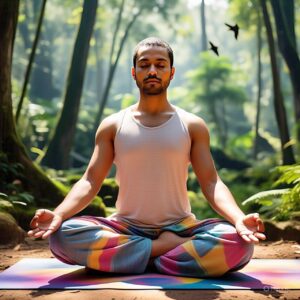
The Benefits of Incorporating Yoga into Daily Routine

Imagine starting your day feeling calm, strong, and energetic—without needing a gym, supplements, or complex routines.
In today’s fast-moving world, where stress, poor posture, anxiety, and digital overload are common, our bodies and minds crave balance. The solution isn’t new—but timeless. It’s yoga, a centuries-old practice that fits perfectly into modern lifestyles.
Yoga is more than just physical exercise. It’s a gentle, holistic approach to wellness—nurturing your body, sharpening your mind, and strengthening your emotional well-being. And the best part? You don’t need to be flexible, athletic, or experienced to start. All you need is a few minutes a day and a willingness to take care of yourself.
Let’s explore how incorporating yoga into your daily routine can transform your life, regardless of your age, lifestyle, or fitness level.
Why We Need Yoga in Our Daily Life
The human body is designed for movement, yet modern routines often involve sitting for long hours at desks, scrolling on devices, or commuting. These habits contribute to:
-
Poor posture and chronic back/neck pain
-
Stress, anxiety, and mental fatigue
-
Muscle stiffness and weak joints
-
Poor digestion and low immunity
-
Fatigue and irregular sleep patterns
Yoga acts as a natural antidote to these modern health issues. It realigns the spine, relaxes the nervous system, promotes circulation, and helps you reconnect with your inner self—physically, mentally, and emotionally.
Physical Benefits of a Daily Yoga Routine
1. Improves Flexibility and Mobility
Yoga gently stretches muscles and connective tissue, improving flexibility and range of motion. Poses like Tadasana (Mountain Pose) and Bhujangasana (Cobra Pose) are great for releasing tension from the spine, hips, and shoulders.
2. Builds Strength and Balance
Yoga builds lean strength through weight-bearing poses. Vrikshasana (Tree Pose) and Plank Pose strengthen the core, legs, and back while improving stability—a key benefit for older adults and injury prevention.
3. Supports Weight Management
While not a high-impact workout, yoga helps regulate weight by:
-
Reducing cortisol (stress hormone)
-
Enhancing mindfulness during meals
-
Improving metabolism through consistent movement
4. Enhances Respiratory Health
Pranayama (yogic breathing) boosts lung function, improves oxygen intake, and helps detoxify the body. It’s especially helpful for those with respiratory conditions or sedentary lifestyles.
5. Boosts Immunity and Digestion
Gentle twists, forward bends, and core exercises stimulate digestive organs and reduce inflammation. Regular practice strengthens immunity by regulating the lymphatic and endocrine systems.
Mental and Emotional Benefits of Yoga
1. Reduces Stress and Anxiety
Yoga is known to reduce cortisol levels and calm the mind. Deep breathing and meditation activate the parasympathetic nervous system—the body’s “rest and digest” mode.
2. Improves Focus and Mental Clarity
Practicing mindfulness through breath and movement helps clear mental fog, enhances concentration, and boosts decision-making skills. This is beneficial for students, professionals, and anyone seeking mental clarity.
3. Enhances Sleep Quality
Yoga promotes deeper, more restful sleep. Relaxing poses like Shavasana (Corpse Pose) or Viparita Karani (Legs-Up-The-Wall) calm the mind and prepare the body for rest.
4. Encourages Positive Thinking
Yoga cultivates mindfulness and present-moment awareness. It improves self-esteem and emotional intelligence, helping you respond to challenges calmly and gracefully.
Who Can Benefit from Daily Yoga?
Yoga is inclusive—it’s for everyone, regardless of age, gender, or ability.
🔸 For Children
-
Improves focus, flexibility, and posture
-
Reduces hyperactivity and digital stress
-
Builds confidence and emotional balance
Recommended poses: Butterfly Pose, Cat-Cow Stretch, and basic breathing
🔸 For Adults
-
Manages stress, back pain, and burnout
-
Increases energy, productivity, and immunity
-
Encourages better lifestyle habits
Recommended poses: Downward Dog, Warrior Series, Tree Pose, Pranayama
🔸 For Elders
-
Enhances joint mobility and balance
-
Reduces stiffness and age-related discomfort
-
Promotes mental calm and emotional well-being
Recommended poses: Chair Yoga, Seated Forward Bend, Mountain Pose
How to Start Yoga as a Beginner
Starting yoga doesn’t require expensive equipment or a fancy studio. You can begin your practice at home with just a mat and an open mind.
✅ 1. Begin with 10–15 Minutes a Day
Start small. Consistency matters more than duration. A short daily practice creates lasting habits.
✅ 2. Learn Basic Asanas
Focus on simple, beginner-friendly poses such as:
-
Tadasana (Mountain Pose)
-
Vrikshasana (Tree Pose)
-
Sukhasana (Easy Sitting Pose)
-
Balasana (Child’s Pose)
-
Bhujangasana (Cobra Pose)
✅ 3. Focus on Breath
Breathing is at the core of yoga. Practice deep belly breathing or Anulom Vilom (alternate nostril breathing) to calm your mind and enhance the effects of each pose.
✅ 4. Be Consistent
Pick a convenient time—mornings for energy or evenings for relaxation. Even 5 minutes daily is better than an hour once a week.
✅ 5. Use Online Resources or Join a Class
Explore free yoga videos, apps, or virtual classes. If you prefer community support, find a local studio or invite a friend to join you.
Inspire Others to Practice Yoga
Your transformation can be a source of inspiration. Share your journey and invite others:
-
Practice with your kids using fun, animal-themed poses
-
Encourage elderly family members with gentle chair yoga
-
Start a mini yoga group at your workplace or in your community
-
Share progress on social media to motivate friends
Yoga spreads light—when one person practices it, the ripple effect inspires many.
Final Thoughts: Make Yoga Your Daily Ritual
Yoga isn’t about perfection—it’s about presence. Incorporating it into your daily routine doesn’t demand major changes, just a small commitment to yourself.
Whether you’re looking for better health, mental clarity, emotional peace, or a deeper connection with yourself, yoga offers a simple and powerful path.
So, begin today.
Unroll your mat. Take a deep breath. And give your body, mind, and spirit the care they deserve.
A healthier, happier you truly begins with just one breath.